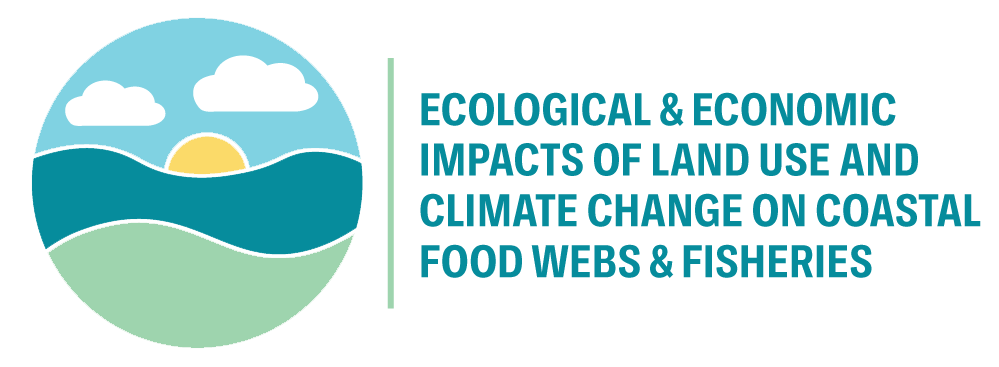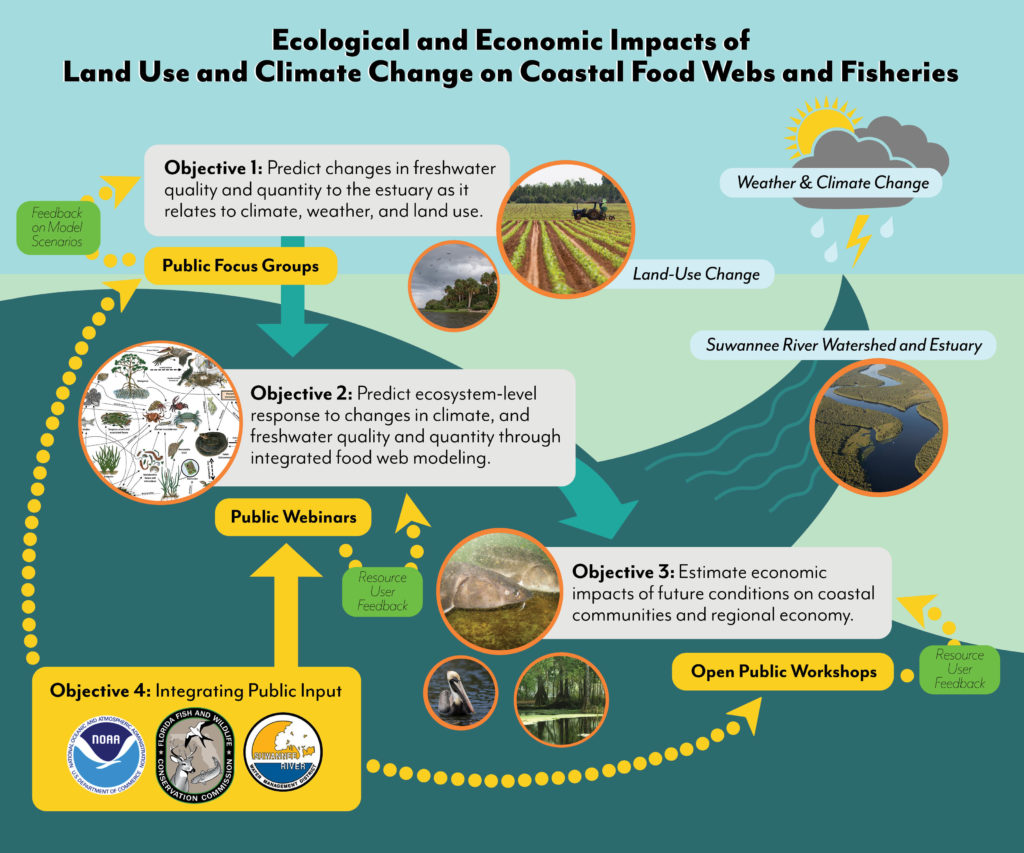
Sponsor
The National Academies of Sciences Engineering and Medicine Gulf Research Program
Award Dates
September 2020 – August 2024
Participants
Project Lead: Micheal Allen (University of Florida)
Project Participants: David Chagaris, Christa Court, Wendy Graham, Kelly Grogan, Holden Harris, David Kaplan, Angela Lindsey, Nathan Reaver, Brett Scheffers, Ricky Telg, and Olesya Savchenko
Goals and Objectives
Effective management of coupled human-natural systems in the Gulf of Mexico will require integrated approaches that consider landscape-level human-induced stressors along with changes in temperature, precipitation, and species distributions resulting from a changing climate. These coupled impacts will ultimately influence the ecological quality and economic value of coastal ecosystem services such as fisheries, aquaculture, and tourism.
This interdisciplinary project included four integrated objectives to evaluate how basin-wide changes in land/water use and a changing climate will influence the quality of natural resources in the Suwannee River estuary, which supports several imperiled species alongside a multimillion-dollar fisheries, aquaculture, and tourism economy.
This project explored how future climate and land-use scenarios would influence natural resources in the Suwannee River Basin. The project included development of a landscape-level watershed model of the Suwannee River Basin (Objective 1) to quantify how changes in land/water use and future climate/weather patterns will influence freshwater quantity and quality delivered to the estuary.
Results from the watershed model informed a trophic-dynamic food web model (Objective 2) to explore how changes in freshwater quality/quantity and changing species distributions will influence fish and shellfish populations that are important to fisheries, aquaculture, and tourism. The project then developed a regional economic model to evaluate the economic implications of changes in market activities associated with each future scenario, as well as a bioeconomic model of clam aquaculture activities to explore profitability under different risk scenarios. The project team also quantified willingness-to-pay associated with changes in habitat (seagrass) and fish abundance for popular recreational fishes (i.e., Red Drum, Spotted Seatrout, and Common Snook) (Objective 3). Throughout the project, integration of the work with the public and state/federal agency partners was conducted with public focus groups, webinars, and facilitated workshops (Objective 4).
 Project flow chart indicating the years for each activity. Project includes monitoring trends in physical ecosystem attributes and multiple species, predicting future hydrologic and habitat conditions, trophic dynamic modeling, economic implications of each scenario, and integration into management.
Project flow chart indicating the years for each activity. Project includes monitoring trends in physical ecosystem attributes and multiple species, predicting future hydrologic and habitat conditions, trophic dynamic modeling, economic implications of each scenario, and integration into management.
Key Findings
- The hydrological (Objective 1) and ecological (Objective 2) models were effective at predicting both river discharge to the estuary and estuarine food web composition relative to historical data in the watershed and estuary.
- Both land-use and climate scenarios were predicted to influence the estuarine food web and the natural resources (e.g., fisheries and aquaculture) it supports.
- Nutrient loading was driven largely by land use in the future scenarios, with the agricultural expansion scenario delivering the most nutrients to the estuary and complete restoration forestry the least.
- Overall, climate factors influencing precipitation patterns had a stronger effect on the estuary natural resources than land use, but both land use and climate were important drivers of natural resources in the estuary. Extreme land use changes (complete agricultural expansion or restored forests) were predicted to have substantial impacts.
- Land-use scenarios that substantially increased agriculture in the basin were predicted to increase nutrient loading, which caused predicted bottom-up increases in production of several fish species. However, negative impacts of increased algae production were predicted to harm seagrasses and thus negatively influence species that support important fisheries.
- This infers tradeoffs where any increases in production in estuarine resources would be at least partially offset by risks of habitat loss (e.g., seagrass coverage) that would affect upper trophic levels.
- Average shellfish aquaculture yields were predicted to increase in the agricultural expansion scenarios, due to bottom-up processes of increased nutrients and primary production. However, there remains high uncertainty in the degree to which increased nutrients would increase the occurrence of harmful algal blooms, which were not simulated in this food web model.
- Risks of higher temperature and lower salinity due to increased precipitation were expected to increase risk of periodic economic losses in the shellfish industry, particularly in Franklin and Levy counties. Thus, although average yields could increase due to higher productivity, higher temperatures, and nutrient loading, climate and land use impacts were expected to increase the risk of periodic crop losses for shellfish aquaculture.
- Total value added and employment levels in the Suwannee River Basin were strongly linked to agriculture, timber, and aquaculture operations, where land-use scenarios that reduced these activities generally reduced both value added and employment. However, modest changes in land use relative to current conditions exhibited decreases in value added and employment that were not offset by minor increases in these variables within some agriculture, forestry, and fishing related sectors.
- Angler surveys showed that anglers were willing to pay increased rates to prevent declines in seagrass abundance and populations of certain fish species. The willingness to pay to prevent declines in fish abundance was highest for Snook, followed by Spotted Seatrout and Red Drum. Survey respondents were only willing to pay more for environmental programs leading to increases in Spotted Seatrout and seagrass abundance.
- The community and science advisory committee for the project was heavily engaged and had an active role in selecting the future scenarios considered, which lays the groundwork for future use of this study for management and policy.
- This project included a significant amount of data synthesis, analysis, and future scenario development that can be used as a baseline for future investigations of management options at local levels, as well as future data collection to improve these models for future policy option explorations.
Project Outputs
Read the Final Report Here Access the Communications Toolkit Here Watch the Project Video

